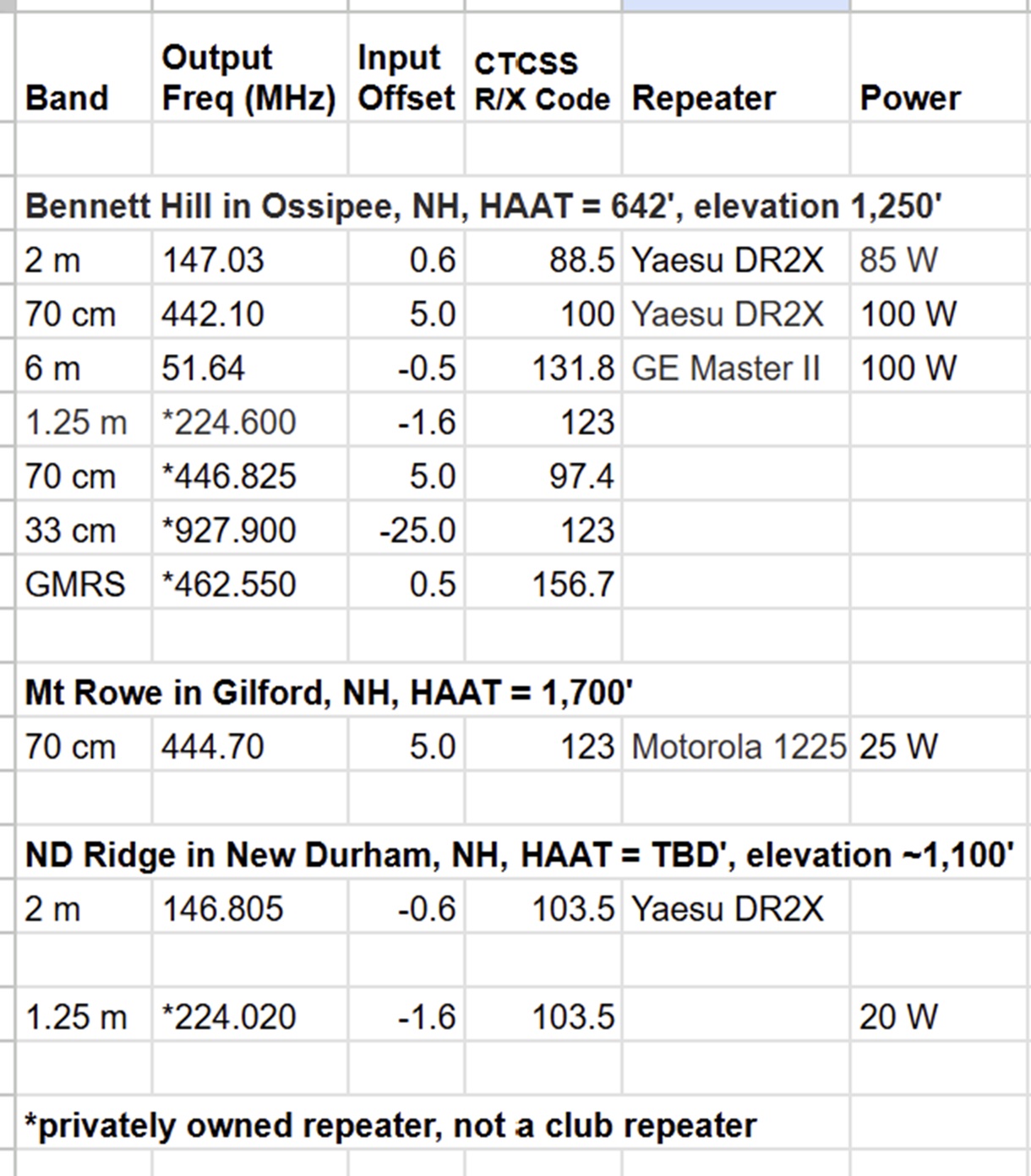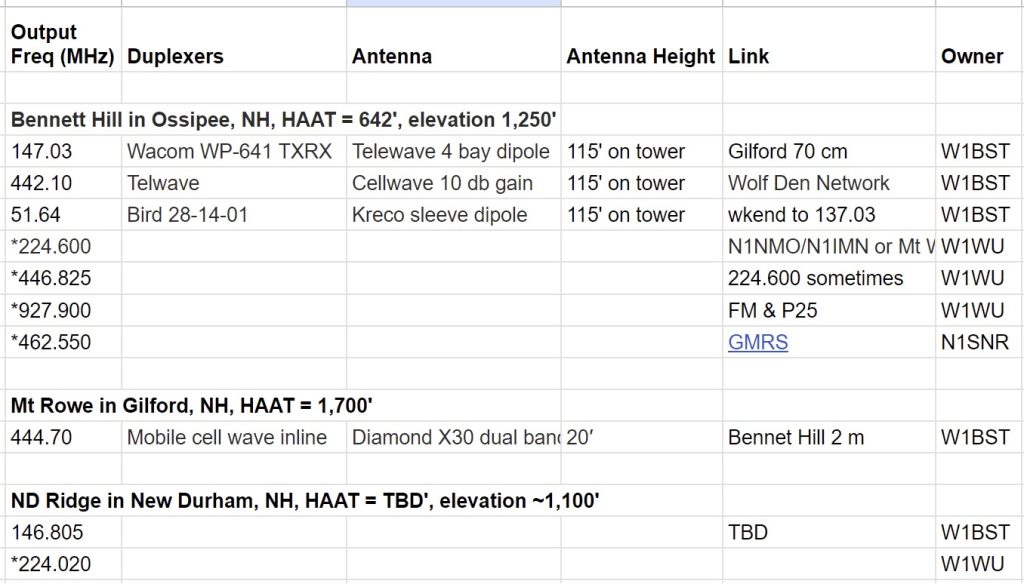Digipeater
LRRA maintains a digipeater at Bennett Hill, Ossipee, NH
(Click the table to view an enlarged copy in a new tab. For a screen reader capable version of the repeater list click here.)
Our club shares space on Bennett Hill and New Durham Ridge with civil, commercial and private entities. Frank/W1WU has several repeaters in the Amateur bands that are open to the public. However, the LRRA is not formally associated with the above commercial or private entities. This information is provided solely in the interest of advancing radio science and the enjoyment of the RF spectrum.
Here’s some additional info on the repeaters, and more will be filled in as it becomes available. (Click the table below to view an enlarged copy in a new tab. For a screen reader capable version of the 2nd half of the repeater table click here.)
What is a Repeater?
A repeater is a two-way radio that has the ability to receive on one frequency and then re-transmit what it has just received on another frequency. It does this at exactly the same time. This is what our repeaters NH do.
Why do we need Repeaters?
Your hand held transceiver has a limited range due to its antenna height? What you need is a repeater system that can transfer your transmitted and received signals to much higher levels. This is done with a repeater that electronically uses high gain antennas, low loss feedings and a transmitter and receiver that is rated heavy or continuous use. A repeater can get your signal out and receive from the station you are talking to with a far greater range and coverage area. You take advantage of the repeater’s higher elevation to increase your effective transmitting and receiving coverage versus your mobile or hand held transceiver.
Our Lakes Region Repeater is located on Bennett Hill which is located in Ossipee, NH and has an elevation of 1253 feet. Our amateur radio repeater antennas are approx. 1,350′ in elevation.
How does a Repeater work?
How to Use Amateur (Ham Radio) Repeaters by N4UJW.
More Info on offsets:
In order for a ham radio repeater to listen and transmit at the same time, repeaters need two different frequencies. For an example let’s use the 2 meter ham band that’s frequency is 600 kilohertz apart.
If the transmit frequency is below 147 MHz then the listening frequency is 600 kilohertz lower. This is referred to a minus (-) offset. If the transmitting frequency is above the 147 MHz then the listening frequency is 600 kilohertz above. This is called a plus (+) off set.
What is Isolation?
Most repeaters use the same antenna to transmit and receive. It is important to have an offset of 600 kHz because if you didn’t, the repeater would hear itself when it was transmitting on the same frequency it was listening on.
Even though the offsets help, the frequencies are close enough that some isolation is needed. Devices such as duplexers, cavities, or cans placed into the coax lines achieve this isolation. This creates the isolation by passing a narrow range of frequencies and rejecting others.
There is some loss to the system, however the advantage of being able to use a single antenna at the repeater site outweighs the drawbacks.
Another Description of Repeaters
Two-way radios have a specific range they operate within and anything outside of that will cause your radio to lose signal. A repeater will help extend your two-way radio range. Radio range can be increased through an repeater. Not only do radio antenna repeaters increase the range we have to communicate, but also they provide clearer voice quality for ease of communication.
Repeater systems are located at higher elevations and receive and re-transmit signals using a higher power so that they reach the intended destinations. Emergency personal, police departments, commercial businesses and ambulance services all use repeaters to ensure important messages are transmitted and received. If you live in a region surrounded by high mountains or tall buildings a repeater is incredibly useful.
Repeater Offset or Shift: Repeaters are built using two different frequencies that seamlessly work together. One frequency transmits the message and the other receives it. In order to use a repeater system you will need to set up your radio so that it is set to receive the repeater’s output frequency. This frequency is how the repeater is identified. You also have to set your radio to offset during your transmission to the repeater input frequency). As a result, the radio transmits on the repeater’s input frequency and reverts to the repeater’s output frequency when your radio is receiving.
Codes: In addition, you must set up your radio with the correct private line (PL) code (a Motorola term, also called sub-audible or CTCSS– Continuous Tone Coded Squelch System) when transmitting or the repeater will not acknowledge the signal. This cuts down on interference from distant repeaters that use the same frequency and a different PL code.
More on PL
Continuous Tone Coded Squelch System, or CTCSS is a communications industry signaling scheme called the Continuous Tone Coded Squelch System (CTCSS).
Below is the terminology used by different commercial companies for CTCSS:
–PL is the Motorola Abbreviation for “Private Line”.
–QC is the RCA abbreviation for “Quiet Channel”.
–CG is the General Electric abbreviation for “Channel Guard”.
CTCSS is often referred to as a “PL” tone by many users. Many repeaters require the use of a PL tone to access the repeater. The frequency that a user transmits to access a repeater is the Repeater CTCSS Encode Frequency. The frequency that the repeater transmits to the user is the Repeater Decode Frequency. Deviation of a transmitted tone should be a maximum of 500Hz.
Motorola decided that they needed their own proprietary name for CTCSS and called their version of it PL (Private Line)
PL and CTCSS are used to prevent a repeater from responding to unwanted signals or interference. They also lessen the annoyance of hearing other conversations when using a shared two-way radio communications channel.
Tone Squelch tells the repeater to respond only to stations that encode or send the proper tone. Most repeaters are “PL’ed”, due to the sheer number of radios and repeaters in their area.


